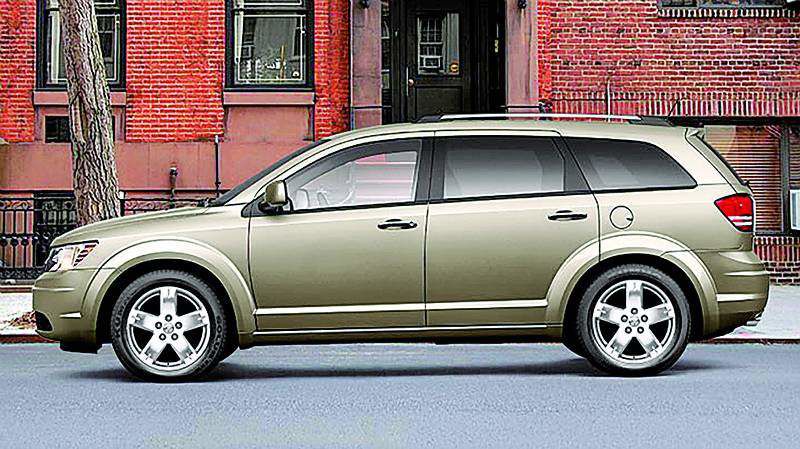Journey into crossover land
Published 5:00 am Sunday, May 4, 2008

- Is the Journey more like a sport utility vehicle or a minivan? The crossover SUV seems to have some bewildering styling cues from each.
Dodge, the brand with powerful Hemi V-8 engines and a brawny image, is showing less brawn in its latest sport utility vehicle.
There’s no Hemi available for the new-for-2009 Dodge Journey SUV. In fact, the base engine for the four-door Journey is a four cylinder.
Trending
Passengers don’t have a big climb up to get inside the Journey, and there’s no truckish, bouncy ride. That’s because the Journey is built on a modified platform of the Dodge Avenger sedan and is a so-called crossover SUV with a carlike ride.
Best of all, the Journey — which is available with seats for five or seven people — has an across-the-board, five-out-of-five star rating in government crash tests, and the vehicle includes some nifty storage spots and convenience features not found on other crossovers.
Some features, such as hidden storage spaces under the carpeting of the second-row floor and at least a dozen other storage spots here and there, come from the minivans that Dodge’s parent company, Chrysler LLC, pioneered.
An early 2009 model, the Journey is positioned between the boxy Dodge Nitro SUV and the larger Dodge Durango, and is the Dodge SUV with the lowest starting price.
Starting manufacturer’s suggested retail price is $19,460 for a base Journey with front-wheel drive, automatic transmission and 173-horsepower, four-cylinder engine. The previous Dodge SUV with the lowest starting retail price was the two-wheel drive 2008 Nitro, which starts at $20,290 with V-6 and manual transmission.
A four-wheel drive Nitro, however, has a lower starting price than an all-wheel-drive Journey — $21,950 for a base Nitro with a manual transmission versus a pricier all-wheel-drive Journey starting at $25,530 with a 235-horsepower V-6 and automatic.
Trending
Competitors in the midsize crossover segment that offer five or more seats include the 2008 Toyota Highlander, which starts at $27,985 with V-6 and automatic, the 2008 Hyundai Santa Fe, which starts at $21,845 with V-6 and manual transmission, and the 2008 Saturn Outlook that starts at $28,995.
While Journey prices may start low, they can reach to the low to mid-$30,000s.
The test, top-of-the-line Journey R/T, with a number of options like moonroof, rear-seat entertainment center and Chrysler’s MyGIG hard drive for music storage, was priced just over $34,000.
The all-wheel drive Journey handled city traffic well, with decent “oomph” from the 3.5-liter, high-output, single overhead cam V-6 that generates 235 horsepower and 232 foot-pounds of torque at 4,000 rpm. But mated to a standard six-speed automatic transmission, the engine sounded a bit noisy when really pressed on mountainous country roads.
And there were times when the shift points in the transmission weren’t smooth.
Fuel economy is lackluster, at just 15 miles per gallon in city driving — per the federal government rating system — and 22 mpg on the highway for the R/T model with all-wheel drive.
As expected, the best mileage rating is for the base, two-wheel drive Journey with 173-horse, 2.4-liter four cylinder. The rating is estimated at 19/25 mpg. But some other crossovers get better mileage.
At nearly 5.6 feet tall, the Journey isn’t so tall as to feel tippy. But the R/T model with all-wheel drive weighed a hefty 4,233 pounds and at times, the weight shifted awkwardly from side to side or front to back, keeping me a bit on edge.
My passengers and I enjoyed good views out of the Journey, save for the big, thick pillars at the sides of the windshield and the rear pillars by the back window.
The Journey’s independent front MacPherson strut suspension and independent rear multilink setup managed to keep most road bumps away from passengers.
But despite the R/T badging — which is meant to denote a sporty, “road and track” personality — the Journey R/T had more mainstream power and steering characteristics.
The interior also had a lot of plastic all around that didn’t look as upscale as I had expected.
Front seats were supportive and nicely positioned. Second-row seat cushions were a bit higher and took a bit more effort to get on. Those seats also slid fore and aft on tracks to help passengers adjust legroom between the second row and the optional third row.
I liked the convenience of the optional two child booster seats that were embedded in the second-row seats. They pulled out and down easily for use and then folded back out of the way when not needed.
The two third-row passengers do sit with their knees up, and legroom back there is for kids at just 23.4 inches. (Toyota’s Highlander offers 29.9 inches in the third row.)
Total cargo space, with the necessary seats folded, is 67.6 cubic feet, which also is less than in some other mid-size SUVs. For example, Hyundai’s Santa Fe has 78.2 cubic feet of cargo room.
Towing capacity of the Journey tops out at 3,500 pounds. Trailer sway control is included.
The Journey’s turning circle of 38.5 feet to 39 feet was larger than expected. The Santa Fe’s turning circle is 35.8 feet.
All safety features, including curtain air bags, electronic stability control with traction control and anti-lock brakes, are standard. A rearview monitor that helps drivers see what’s behind as they back up is optional.
2009 Dodge Journey
Base price: $19,460 for base, two-wheel-drive SE; $22,360 for two-wheel-drive SXT; $24,905 for all-wheel-drive SXT; $25,920 for two-wheel-drive R/T; $27,670 for R/T with all-wheel-drive
As tested: $34,015
Type: Front-engine, all-wheel-drive, seven-passenger, midsize sport utility vehicle
Engine: 3.5-liter, high-output, single overhead cam V-6
Mileage: 15 mpg (city), 22 mpg (highway)
Top speed: 118 mph
Length: 192.4 inches
Wheelbase: 113.8 inches
Curb weight: 4,233 pounds
Built in: Mexico








